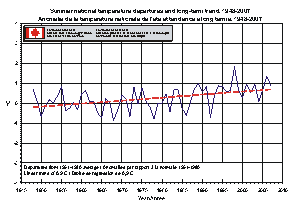Climate Trends and Variations Bulletin
Temperature & Precipitation in Historical Perspective
Summer 2007
National Temperature
 The
summer of 2007 was the 7th warmest Canada has experienced since nationwide records
began in 1948, 0.9°C above normal, based on preliminary data. The warmest
summer was 1998, 1.8°C above normal, and the coolest year was 1968, 0.8°C
below normal. The map to
the right shows that most of the country experienced temperatures less than
1°C above normal, with some of the arctic islands having temperatures slightly
more than 2°C above normal. With the exception of the springs of 2002
and 2004, seasonal temperatures have remained
above or near normal for the last 10 years, as shown in the consecutive
seasons graph. The
summer of 2007 was the 7th warmest Canada has experienced since nationwide records
began in 1948, 0.9°C above normal, based on preliminary data. The warmest
summer was 1998, 1.8°C above normal, and the coolest year was 1968, 0.8°C
below normal. The map to
the right shows that most of the country experienced temperatures less than
1°C above normal, with some of the arctic islands having temperatures slightly
more than 2°C above normal. With the exception of the springs of 2002
and 2004, seasonal temperatures have remained
above or near normal for the last 10 years, as shown in the consecutive
seasons graph.
 The
graph to the left shows
that summer temperatures have generally been increasing nationally, with temperatures
remaining at or above normal since 1993. The red dashed line represents a warming
trend of 0.9°C over the last 60 years. Listed in the national
warmest/coolest temperature table are the ten coolest and warmest summers
for the entire country. The national
temperature departures table shows the full list of summers in the order
from warmest to coolest, and shows that 5 of the warmest 10 summers have occurred
within the last 10 years. The
graph to the left shows
that summer temperatures have generally been increasing nationally, with temperatures
remaining at or above normal since 1993. The red dashed line represents a warming
trend of 0.9°C over the last 60 years. Listed in the national
warmest/coolest temperature table are the ten coolest and warmest summers
for the entire country. The national
temperature departures table shows the full list of summers in the order
from warmest to coolest, and shows that 5 of the warmest 10 summers have occurred
within the last 10 years.
National Precipitation
 Overall,
Canada experienced its 28th wettest summer, out of the 60-years of record, 2.9%
above normal, based on preliminary data. The map
to the right shows the wetter than normal areas, those more than 40% wetter
than normal, include: northern B.C.; southern Yukon; the border area between
Northwest and Nunavut territories; and Nova Scotia. Areas of southern B.C.,
Alberta, and Saskatchewan, areas in central and southern Ontario, and an area
covering some of the arctic islands all experienced at least 40% less precipitation
this summer. Overall,
Canada experienced its 28th wettest summer, out of the 60-years of record, 2.9%
above normal, based on preliminary data. The map
to the right shows the wetter than normal areas, those more than 40% wetter
than normal, include: northern B.C.; southern Yukon; the border area between
Northwest and Nunavut territories; and Nova Scotia. Areas of southern B.C.,
Alberta, and Saskatchewan, areas in central and southern Ontario, and an area
covering some of the arctic islands all experienced at least 40% less precipitation
this summer.
It should be noted that "normal" precipitation in northern Canada
is generally much less than it is in southern Canada, and hence a percent departure
in the north represents much less difference in actual precipitation than the
same percentage in the south. The national precipitation rankings are therefore
often skewed by the northern departures and do not represent rankings for the
volume of water falling on the country.
 The graph to the left
shows that most summers since 1973 have had precipitation levels near or above
normal. As shown in the national
precipitation wettest/driest table, the wettest summer was 2005 (+21.2%)
and the driest was 1958 (-14.3%). The national
precipitation departures table shows the full list of summer precipitation
values in order from wettest to driest. The consecutive
seasons graph shown that when comparing the seasonal values over that last
three years, precipitation values have tended to be wetter than normal.
The graph to the left
shows that most summers since 1973 have had precipitation levels near or above
normal. As shown in the national
precipitation wettest/driest table, the wettest summer was 2005 (+21.2%)
and the driest was 1958 (-14.3%). The national
precipitation departures table shows the full list of summer precipitation
values in order from wettest to driest. The consecutive
seasons graph shown that when comparing the seasonal values over that last
three years, precipitation values have tended to be wetter than normal.
Continue to the Regional Analysis...
Created :
2002-02-25
Modified :
2007-06-01
Reviewed :
2007-06-01
Url of this page : http://www.msc.ec.gc.ca
/ccrm/bulletin/national_e.cfm

The Green LaneTM,
Environment Canada's World Wide Web Site.
|